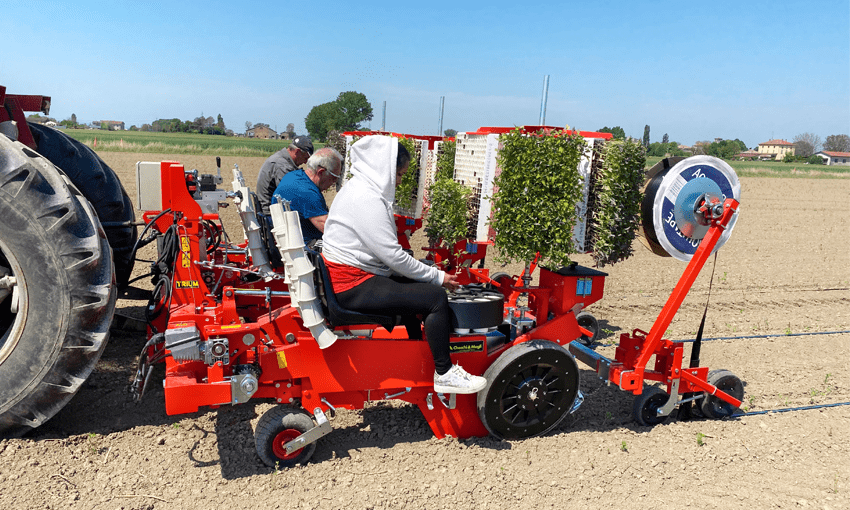
Transplanter: what it is, what it is used for and how it works?
What is a transplanter?
The transplanter is an instrument carried, towed or self-propelled, which allows a certain quantity of seedlings to be planted in the ground at a predetermined distance.
Very often, these are semi-automatic or automatic machines for which the presence of one or more operators is required.
What are the components of a transplanter?
Semi-automatic transplanter with rotating distributor
It is the most common type of transplanter: it is an instrument consisting of a frame on which one or more transplant elements are fixed, elements fixed at a distance equal to the desired inter-row spacing.
Each transplant element corresponds to a seat on which the operator sits, who has the task of taking the seedlings from the trays to finally place them on the rotating distributor.
The heart element of the transplantation element is, therefore, the rotating distributor: this element is typically made up of a cylinder with a series of openings, called cups, inside which the operator inserts the seedlings after having carefully selected them.
It is a device, protected and integrated with the share which, with an alternative movement, pushes the plant inside the furrow created by the share itself (the rotation speed of the distributor depends on the speed of the tractor and the distance at which seedlings must be placed).
Automatic transplanters
In the case of automatic transplanters, the transplantation system is more complex but allows to reduce the number of operators necessary for the operation. These machines, in fact, only require a single operator who feeds, with trays containing the plants and the loading guides of the transplanting element.
The machine then automatically extracts the seedlings thanks to a system of ejectors; a system of pliers or discs then provides to deposit them on the ground.
Distributor handling
In a traditional (non-electric) transplanter, the movement of the distributor is obtained through a mechanical transmission, chain-pinions, which distributes the rotation of one or more wheels in contact with the ground (the transplant distance, which depends on the type of plant, is adjusted by acting on the gear ratio between the wheel on the ground and the distributor shaft).
Auxiliary devices
Transplanters often provide for the distribution of fertilizer and micro granules necessary for the development of the plant.
These are generally volumetric distributors, with screw or vane, suitable for treating solid granular products (in other cases, it is combined with localized watering devices synchronized with the plant).
What is a transplanter used for and where it is used in particular?
Transplanters are typically used for vegetables (tomatoes, leeks, salads, onions, ...), tobacco, strawberries, etc., whose seedlings are grown in greenhouses inside trays (they can be both bare root and with a plate of different shapes, cubic, pyramidal, conical, cylindrical).
It is, therefore, clear that the use of transplanters allows for a substantial reduction in the manpower for planting seedlings.
What are the advantages of the electrical application?
The transplanter market has begun to consider applications where the movement of the distributors is achieved through electric motors.
Although the diffusion of electrical transplant systems is still limited, the application with electric motors has some advantages over the traditional solution:
- The wheel on the ground no longer transmits motion but is only connected to an encoder or to a phonic wheel that provides a speed or position reference to the motors (by not transmitting motion, it no longer runs the risk of slipping on the ground, preventing thus to create transplant irregularities on particularly humid soils);
- It is possible to set the distances between the plants and adjust the amount of fertilizer or micro granulate with greater flexibility (since it is not bound by a limited series of mechanical transmissions, it is enough to change the settings from a practical panel);
- It is possible to have a diagnosis and an automatic timely intervention in cases of blockages or non-functioning on the individual elements before an excessive effort, avoiding the risk of breakage and/or non-transplant sections;
- The use of electric motors allows control over the speed and torque of the distributors, ensuring that, during operation, the maximum preset values are not exceeded, avoiding the risk of missing deposits due to the lack of supply of seedlings or jam.
What role does ROJ Agri-Motion play in the general transformation process from traditional transplanters to electric transplanters?
ROJ has several years of experience in the application of electric motors to distribution, sowing and transplanting systems, both as a first plant and as an after-market and can support the customer in the choice of components and system integration.
ROJ provides a basic system, called PCS 150, for the control of transplanters, which includes:
- Motors for distributors and micro granulator;
- Control unit (ECU);
- ROJ Agri-Mate display;
- Power distribution box;
- Machine speed and position sensors;
- Related wiring.

